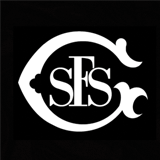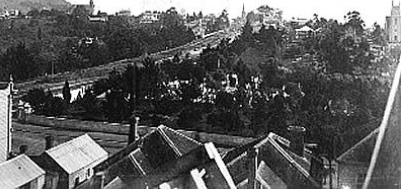HISTORICAL VIEW OF SYMONDS STREET CEMETERY
Symonds Street Cemetery View south 1860s
This view from Partington’s Windmill shows the scoria rock wall around the Cemetery. Note the absence of shrubs or trees. At the rear can be seen two Gothic Churches; on the left is the 1865 Anglican Chapel of the Holy Sepulchre, on the right of Symonds Street and centre of the image is the 1866 Catholic Chapel of St Francis de Sales.
The small structure sitting by itself in the Jewish sector is a wooden mortuary chapel. The Orthodox Jewish Rite requires a vigil of three days and nights to be held over the body of a deceased person before burial - this vigil shouldn’t be held in a residence or the Synagogue - hence the neccessity of the building here.
Note how the Jewish structure is a very plain structure which avoids any architectural symbolism or style unlike the other two buildings.
Symonds Street Cemetery View south 1870s
Another view taken ten years later from Partington’s Windmill. The two gothic Chapels at the rear have been joined by the Presbytarian Newton Kirk (right centre) also designed in the Gothic style.
An assortment of trees and shrubs have appeared, being Weeping Willow, Cypress, Camellia and Box. Some of the graves will be planted with small flowering shrubs such as roses with underplantings of ivy, violets and bulbs.
Symonds Street Cemetery View south 1884
Another view from the Windmill, showing the corner of the Caledonian Hotel (left) and the new St Benedicts (upper right). Upper left is the new Church of the Holy Sepulchre on Khyber Pass Road. The trees have now grown up obscuring the Jewish Mortuary Chapel. These trees will mostly be evergreen and probably Pinus radiata which was considered a good subsitute for yew.
Pinus radiata actually grew too fast and too big resulting in inartistic straggly trees. It is probable that most of the English Oak trees and Cypresses were planted at this time to replace them.
Symonds Street Cemetery View south 1923
Another view from the Windmill. The Jewish Mortuary Chapel has gone as the front part of the Jewish Cemetery has been laid out as a Public Park which is largely obscured by the shops in the foreground. A jewish mortuary Chapel appears on the maps at this time situated out of range of the photo to the right - possibly it was the original building simply relocated.
Note how the Presbytarian area has largely reverted to an open aspect devoid of large trees or shrubs.
Symonds Street Cemetery View south 1950
Probably the last view from the Windmill before it was demolished in 1950. The corner park has now been redesigned in the post-war modernist style with broad areas of lawn. The trees in the stream valley to the right background have developed into a bosky dell. In the foreground is a neon sign on the roof of the Maples Furnishing Company.
Symonds Street Cemetery View south 2009
This view from the highrise carpark building approximates the previous photographs taken from Partington’s Windmill. The park in the foreground occupies the part of the Jewish Cemetery which had never been used for internments.
In the middle of the lawn is the “Karangahape Rocks” Fountain of 1968. The trees are mostly evergreens; a mixture of exotics and native species.






